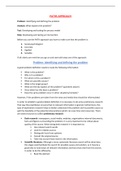PATHS APPROACH
Problem: Identifying and defining the problem
Analysis: What explains the problem?
Test: Developing and testing the process model
Help: Developing and testing an intervention
Before you use the PATH approach you have to make sure that the problem is:
1. Social-psychological
2. Concrete
3. Applied
4. Solvable
If all criteria are met then you go on and start with step one of the approach:
Problem: identifying and defining the problem
A good problem definition needs to state the following information:
What is the problem?
Why is it a problem?
For whom is this a problem?
What are possible causes?
What is the target group?
What are the key aspects of the problem? (questions above)
Since when has this been a problem?
Does the same problem occur in other situations/contexts?
However, if the problems are taken from the news and media they should be reformulated.
In order to establish a good problem definition it is necessary to do some preliminary research.
That way the practitioner ensures that no relevant information is ignored, furthermore, this
type of exploratory research helps to better understand the problem and its possible causes as
well the feasibility of the potential interventions (which can save time and resources). There
are several sources to collect preliminary research:
Desk research: newspapers, social media, websites, organizations internal documents,
facts and figures surrounding the problem. It is very important to be critical about
quality of the source. When doing desk research it is important to:
1. Use relevant search words
2. Look for reliable sources
3. Distinguish facts from opinions
4. Consult the original source
5. Take into account how recent is the information.
Scientific literature: Although a more systematic literature search will be done later,
this stage could facilitate the search for possible causes and solution, so it may be a
good idea to note down all relevant information and facts that arise from this search.
In order to do this efficiently:
1. Read the abstract
, 2. Scan subheadings
3. Look for the research questions
4. Check the sampling
5. Check how the outcome variable is operationalized
6. Look at tables and figures
7. Read the study’s limitations
Interviews: conduct interviews with individuals who are party to the problem is very
important to get an intuitive understanding of the problem and to see how they
experience the problem and whether there are discrepancies. The people that needs
to be interviewed are the people who are affected by the problem, people who cause
the problem, and people who are responsible for solving the problem. The interviews
should be relatively unstructured
Observations: Observations should be conducted in order to gather more reliable data
since sometimes the discrepancies between interviewees can be too large to agree on
a problem definition. Or sometimes, with sensitive topics, the practitioner can be
suspicious about all interviewees agreeing on the same issue, when it fact it does not
appear to be the case. When conducting observations, an unstructured observation
method is advised, in such method, topics to pay attention to will be noted down to
keep track on the important issues that need to be observed. It is advised that the
practitioner remains unidentified since people may behave differently when they know
they are being watched (Hawthorne effect).
Example of why psychological variables are needed: the broken windows theory – Groningen
field experiment in an alley.
Example: Social media use at night
1. What kind of problem is this? Does it meet the criteria? (Appropriate answers to these
questions will make the analysis easier).
Psychological?
Social pressure, insecurities, stress, depression, self-image
Applied?
More than just understanding, the problem needs to be resolved so it focuses on
solutions!
Concrete?
Specific target group, specific issue
Solvable?
Can be to an extent, for instance, in a specific school rather than globally. This refers
to resources, scale, and time.
2. If so, define the problem
What?
Low quality sleep (too short, waking up) due to social media use
Why?
Depression, stress, self-esteem, concentration, fatigue
Who?
Teenagers, their families, teachers
Causes?
FOMO, peer pressure
Target group?





